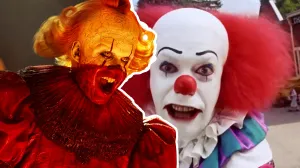The tradition of Japanese animated films did not die with Studio Ghibli’s bygone hiatus. Thanks to a team of veterans, Studio Ponoc fill in the gaps which acclaimed director Hayao Miyazaki left following his (debunked) retirement. The fledgling studio is now preparing for U.S. screenings of its first film Mary and The Witch’s Flower, and ComicBook.com had the chance to speak with its director and producer about the project.
Videos by ComicBook.com
Director Hiromasa Yonebayashi is the man responsible for Mary and The Witch’s Flower, and anime lovers should know his name. The animator got his humble start with Studio Ghibli on Princess Mononoke, and Yonebayashi worked very closely with Miyazaki on a dozen more features. After earning an Academy Award nomination for When Marnie Was There, Yonebayashi joined Studio Ponoc to carry on his mentor’s legacy.
As for Yoshiaki Nishimura, the producer also comes from Studio Ghibli’s hallowed halls. The producer began his work with Howl’s Moving Castle in 2004 before earning consecutive Academy Award nominations for his work with Miyazaki. Now, Nishimura oversees Studio Ponoc as its founder, and he had plenty to say about Mary and The Witch’s Flower alongside his colleague.
****
On how Studio Ponoc turned The Little Broomstick into an anime classic:
Q: I want to say I’m a big fan of Mary and The Witch‘s Flower; it’s a beautiful film. I understand that it’s originally based on a children’s tale which Mary Stewart wrote. I wanted to first how did both of you approach this story as it was originally a children’s tale and adapt it into a feature film? What was your first introduction to the story?
Nishimura: When Studio Ghibli closed its production division in 2014, we wanted to make a film using many of the Studio Ghibli staff. For the first film for the new studio, Studio Ponoc, I was very interested in using director Yonebayashi who was a master at depicting the dynamic animation that he was in charge of under director Hayao Miyazaki. I think he is the one who has inherited that type of filmmaking from Mr. Miyazaki. I read many children’s books, of course, to look for material, and I was interested in a film that would feature a witch.
When I looked and read various children’s book featuring witches and magical situations, all of them face their difficulties with magic and solve their difficulties or the problems with magic with the exception of Mary in The Little Broomstick when she faced the most difficult situation. She says, “I’m going to open this door without magic. No matter how long it takes me, I’m going to open it on my own.” So, she rejects using magic when facing a difficulty. This seemed to be symbolic of the situation we started in with this new studio because we were no longer under the magic umbrella of Studio Ghibli, and we had to face the new reality on our own without magic. So, that was the concept that we had.
In the original story, as it’s titled The Little Broomstick, the broomstick plays a major … character, but the original story also has a flower that Mary discovers called Fly-by-Night which gives magical power to Mary. This power is a very great power, and I wondered when you’re given a great power, how do you use it? In this story, there are aspects which, once you have that kind of power, it kind of goes into the bad direction. So, I thought that it’s sort of like Prometheus’s fire. It gives a huge power to humans, and the humans become drunk with this power, so that they start abusing the power. In terms of what we want to express to our daughters and sons, I thought we could show what Mary does by rejecting the magic.
Yonebayashi: In making this story into a film, I thought it would be great to have a theme, and one theme I came up on was transformation. In the film, there are animals that have been transformed, and it’s a film where Mary transforms as she develops as a girl. Madame Mumblechook and Doctor Dee are doing experiments to transform others into something they think will be good. So, they’re doing transformational experiments whereas Mary is wanting to change, and she is able to change through her inner strength. These types of transformations I thought would be a good theme to deal with in this film. I think we are surrounded by situations where people are trying to change other people. For example, in schools, there’s a certain way of thinking being pushed onto students. It’s that kind of situation we need to be careful and wary against so that we can transform ourselves from our insides.
On how Studio Ponoc will carry on Studio Ghibli’s traditions:
Q: Earlier on, I believe Nishimura-san’s answer, he mentioned that Mary and the Witch‘s Flower is no longer under the magical umbrella of the Studio Ghibli now that its era has come to a close. A lot of U.S. fans in particular are looking at this film as a point of comparison to what Studio Ghibli did in the past. I was wondering what you both hope this new film will say about Studio Ponoc and this next era of Japanese animation?
Nishimura: What we learned being at Studio Ghibli was not a way to make films through some sort of tradition or because it’s a business; The main purpose of making animation is to look at what present-day children are facing and thinking and to communicate something to them. Because it’s a new age or there’s new technology or the new systems or new distribution systems like streaming — we don’t want to get caught up in those technicalities. We want to keep our focus on what we want to communicate to children in this age. It’s not that we’re trying to do something new but rather trying to keep the focus on that crucial element.
On the merits of Mary Smith:
Q: Mary Smith is arguably one of the best protagonists to come out in an anime feature film in a very long time. I wanted to ask what you both think she has as a heroine that resonates with audiences?
Yonebayashi: I think whether one is a child or one is an adult, it takes a lot of courage to take a step toward a new goal in one’s life. Mary is a character who acts and steps out before she thinks. In a way, she makes a lot of mistakes and fumbles around, but she does work up a lot of courage in order to go save her friend, and she does so no matter how many times she falls down. Whatever difficulties she faces, she keeps moving forward. I hope people watching the film will watch Mary and get the courage to go on in their lives and to make that extra step to fulfill what they want to do in their life, whether they are children or adults.
On the film’s reception with U.S. audiences:
Q: American fans are very excited to see this film, it’s been hyped a lot within social media. I wanted to ask what both of their hopes are for the film’s reception here by Western fans, and if there’s just any final parting words they would like their fans here in the U.S. to know?
Yonebayashi: Having been at Studio Ghibli for 20 years as an animator, I learned a lot about animation from Hayao Miyazaki, and I put much of what I learned into this film. I crammed it full of things that I learned at Studio Ghibli, and I think it’s turned out into a very enjoyable, entertaining piece of film, so I hope that people who see it will be entertained and feel impacted by it.
Nishimura: I am fully convinced that the people who love Studio Ghibli films will love our films as well.
****
If you would like to see Mary and The Witch’s Flower when it hits theaters for a limited run, you can purchase your tickets now through Fathom Events here. Fathom Events will host a special premiere screening on January 18th before the film’s theatrical release on January 19th.
Will you be seeing Studio Ponoc’s debut film? Hit me up on Twitter @MeganPetersCB to let me know and talk all things comics, k-pop, and anime!








